The identification of c#Authentication Code is mainly divided into three steps: preprocessing, segmentation and recognition.
First I download the verification code from the website
The results are as follows:
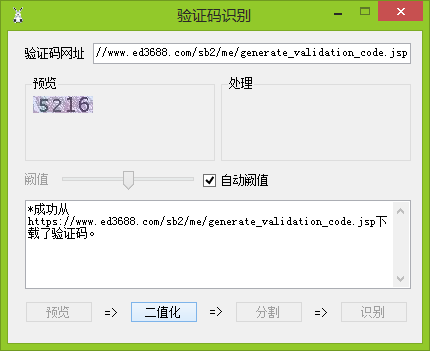
1. Picture preprocessing, that is, binary pictures
*Sets the gray value of the pixel point on the image to 0 or 255.
The principle is as follows:
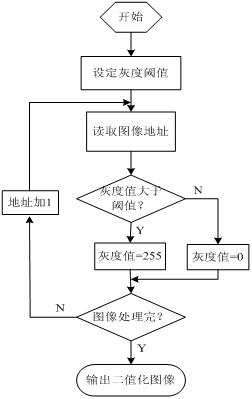
The code is as follows:
#region Binary Picture
/// <summary>
///Binary Picture
///is to set the gray value of the pixel point on the image to 0 or 255
/// </summary>
/// <returns>Authentication code after processing </returns>
public Bitmap BinaryZaTion()
{
for (int x = 0; x < img.Width; x++)
{
for (int y = 0; y < img.Height; y++)
{
__c = img.GetPixel(x, y);
//Gray value
int __tc = (__c.R + __c.G + __c.B) / 3;
//Greater than Que Black
if (__tc > t)
{
img.SetPixel(x, y, Color.FromArgb(__c.A, b, b, b));
//Black dots add themselves
__blackNum++;
}
//Greater than Que White
else
{
img.SetPixel(x, y, Color.FromArgb(__c.A, w, w, w));
}
}
}
return img;
}
#endregion
After binarization, you need to determine the black-to-white ratio of the picture. If there is more black than white, you need to reverse the color of the picture.
The code is as follows:
#Whether region needs inversion
/// <summary>
///Need Inversion
/// </summary>
/// <returns>Need backcolor </returns>
public bool IsNeedInverseColor()
{
if ((__blackNum * 1.0 / (img.Width * img.Height)) > 0.5)
{
return true;
}
else
{
return false;
}
}
#endregion
#region Inversion
/// <summary>
///Inverse color
/// </summary>
/// <returns>Authentication code after processing </returns>
public Bitmap InverseColor()
{
for (int x = 0; x < img.Width; x++)
{
for (int y = 0; y < img.Height; y++)
{
__c = img.GetPixel(x, y);
img.SetPixel(x, y, Color.FromArgb(__c.A, w - __c.R, w - __c.G, w - __c.B));
}
}
return img;
}
#endregion
The results are as follows:
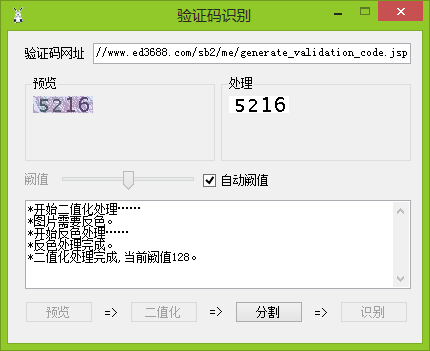
2. Picture segmentation
My practice is to first determine if each vertical line is a pure white line, not record the current x-coordinate, and then not horizontally determine if it is a pure white line, so you can go to the area of each number and draw the area.
The code is as follows:
#region Split Picture
/// <summary>
///Split Picture
/// </summary>
/// <returns>Authentication code after processing </returns>
public Bitmap CutImg()
{
//Y-axis Split
CutY();
//Number of Areas
__count = 0;
if (XList.Count > 1)
{
//x Start Value
int __start = XList[0];
//x end value
int __end = XList[XList.Count - 1];
//x index
int __idx = 0;
while (__start != __end)
{
//Area Width
int __w = __start;
//Number of Areas Added
__count++;
while (XList.Contains(__w) && __idx < XList.Count)
{
//Area Width Adds
__w++;
//x-index self-addition
__idx++;
}
//Area X-axis coordinates
int x = __start;
//Area Y-axis coordinates
int y = 0;
//Area Width
int width = __w - __start;
//Area Height
int height = img.Height;
/*
* X Axis Split Current Area
*/
CutX(img.Clone(new Rectangle(x, y, width, height), img.PixelFormat));
if (YList.Count > 1 && YList.Count != img.Height)
{
int y1 = YList[0];
int y2 = YList[YList.Count - 1];
if (y1 != 1)
{
y = y1 - 1;
}
height = y2 - y1 + 1;
}
//GDI+Drawing Objects
Graphics g = Graphics.FromImage(img);
g.SmoothingMode = SmoothingMode.HighQuality;
g.CompositingMode = CompositingMode.SourceOver;
g.PixelOffsetMode = PixelOffsetMode.HighSpeed;
g.InterpolationMode = InterpolationMode.HighQualityBicubic;
//Draw Authentication Code Area
g.DrawRectangle(new Pen(Brushes.Green), new Rectangle(x, y, width, height));
g.Dispose();
//Start value points to next group
if (__idx < XList.Count)
{
__start = XList[__idx];
}
else
{
__start = __end;
}
}
}
return img;
}
#endregion
#region Y-axis Character Split Picture
/// <summary>
///Get Y-Axis Split Points
///Determine if each vertical line is black
///or add
/// </summary>
/// <param name="img">Picture to verify </param>
private void CutY()
{
XList.Clear();
for (int x = 0; x < img.Width; x++)
{
isWhilteLine = false;
for (int y = 0; y < img.Height; y++)
{
__c = img.GetPixel(x, y);
if (__c.R == w)
{
isWhilteLine = true;
}
else
{
isWhilteLine = false;
break;
}
}
if (!isWhilteLine)
{
XList.Add(x);
}
}
}
#endregion
#region X-axis Character Split Picture
/// <summary>
///Get X-Axis Split Points
///Determine if each line is black
///or add
/// </summary>
/// <param name="tempImg">Temporary area</param>
private void CutX(Bitmap tempImg)
{
YList.Clear();
for (int x = 0; x < tempImg.Height; x++)
{
isWhilteLine = false;
for (int y = 0; y < tempImg.Width; y++)
{
__c = tempImg.GetPixel(y, x);
if (__c.R == w)
{
isWhilteLine = true;
}
else
{
isWhilteLine = false;
break;
}
}
if (!isWhilteLine)
{
YList.Add(x);
}
}
tempImg.Dispose();
}
#endregion
The results are as follows:
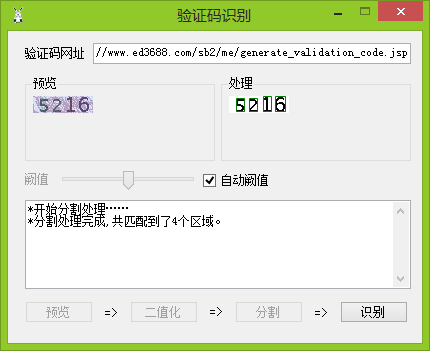
3. Identify
Recognition is extracting the features of a picture
My approach is to divide the digital area of the picture into 4*4 areas one by one, calculate the percentage of black dots in each area, and then compare the calculated results with the previously calculated features to find the minimum Euclidean distance d = sqrt ((x1-x2)^2+ (y1-y2)^2) as the result.
Part of the code is as follows:
#region Black Pixel Ratio Column
/// <summary>
///Calculate black pixel ratio column
/// </summary>
/// <param name="tempimg"></param>
/// <returns></returns>
private double PixlPercent(Bitmap tempimg)
{
int temp = 0;
int w_h = tempimg.Width * tempimg.Height;
for (int x = 0; x < tempimg.Width; x++)
{
for (int y = 0; y < tempimg.Height; y++)
{
__c = tempimg.GetPixel(x, y);
if (__c.R == b)
{
temp++;
}
}
}
tempimg.Dispose();
double result = temp * 1.0 / w_h;
result = result.ToString().Length > 3 ? Convert.ToDouble(result.ToString().Substring(0, 3)) : result;
return result;
}
#endregion
The results are as follows:
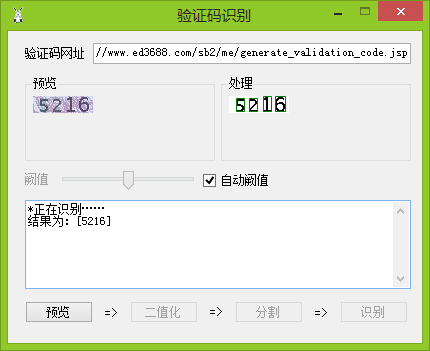
This code is for research purposes only.
Novice on the road, contact pigkeli@qq.com for any suggestions or comments.
Reprinted at: https://www.cnblogs.com/riasky/p/3473365.html